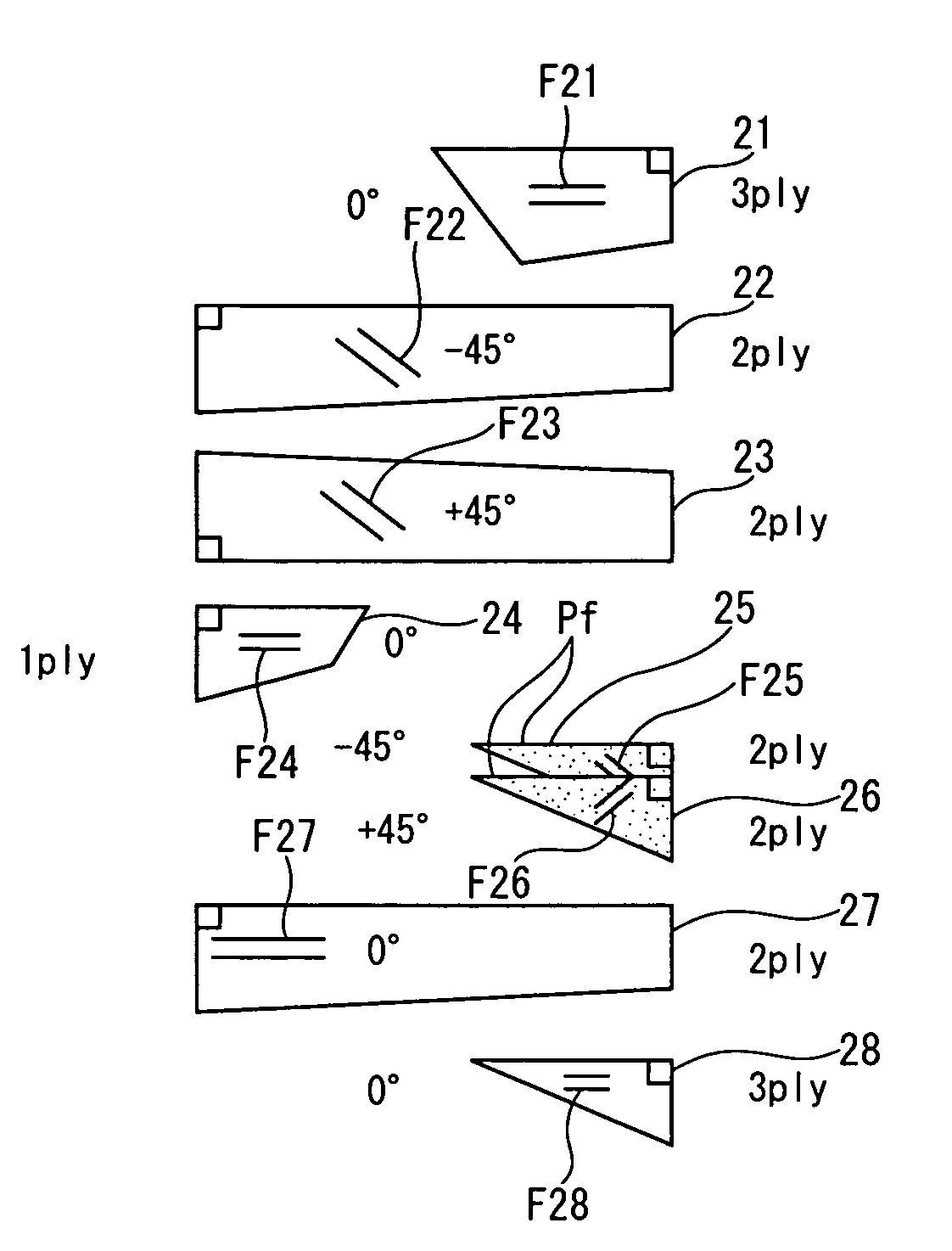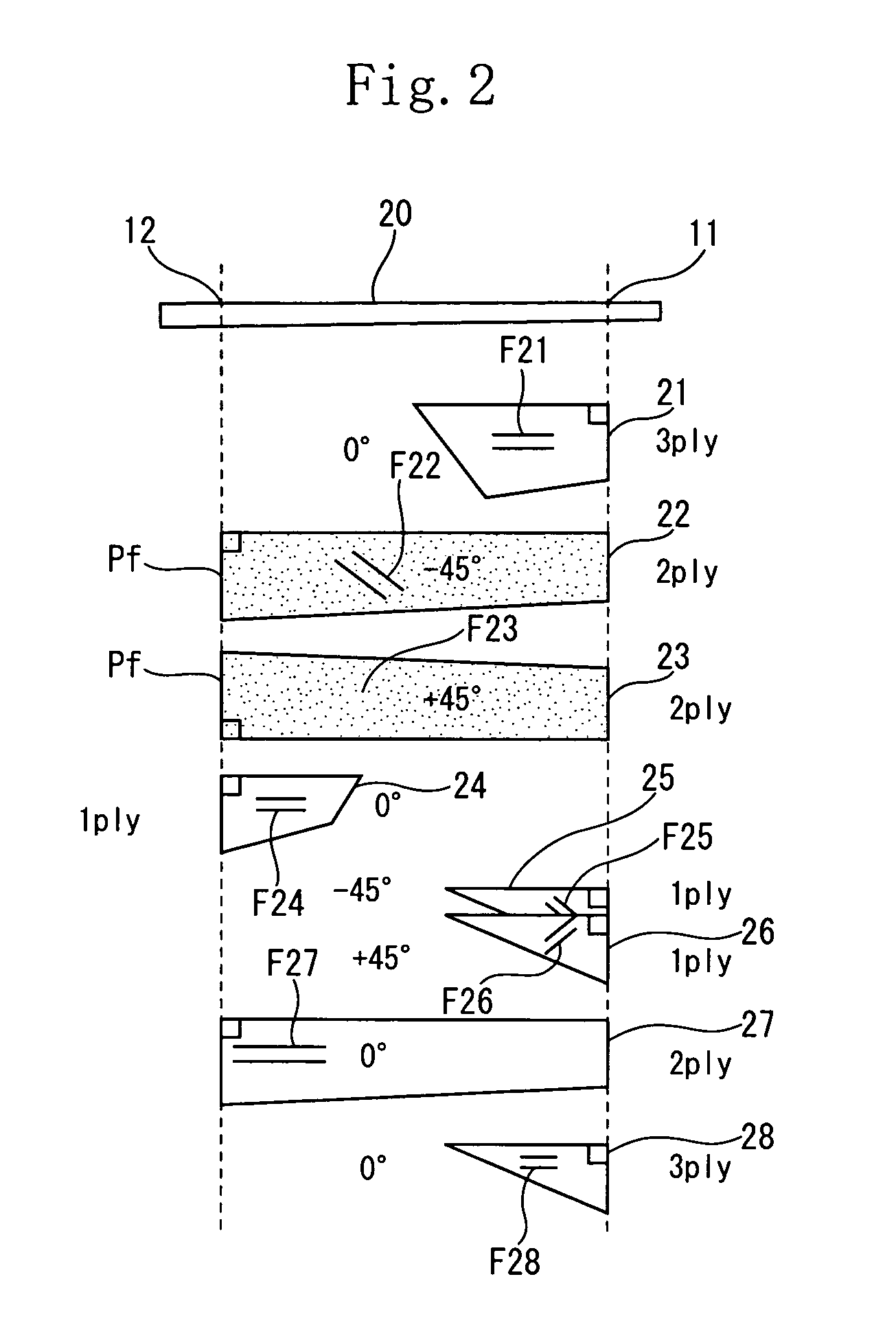Golf club shaft
a technology for golf clubs and shafts, which is applied in the field of golf club shafts, can solve the problems of difficult to manufacture carbon nano-tubes having a uniform size, difficult to manufacture shafts with light weight, and low strength of shafts manufactured by using these methods, so as to enhance the torsional strength and torsional rigidity of shafts, and increase the weight of shafts and bending rigidities. , the effect of high energy absorption performan
- Summary
- Abstract
- Description
- Claims
- Application Information
AI Technical Summary
Benefits of technology
Problems solved by technology
Method used
Image
Examples
example 1
[0106]The layered construction of prepregs was identical to that of the second embodiment. More specifically, a fifth-layer prepreg 25 and a sixth-layer prepreg 26 were formed as fullerene-containing prepregs. A mandrel was wound with two turns of the prepregs 25, 26 to form fullerene-containing bias layers in only a range spaced at an interval of 300 mm from the head-side tip of the shaft. Each of the prepregs 25, 26 contains said fullerene or / and said fullerene compound at not less than 0.002 wt % of the weight of said matrix resin, namely, the epoxy resin.
[0107]The prepreg a was used as the first layer 21. The prepreg b was used as the second layer 22 and the third layer 23. The prepreg c was used as the fourth layer 24. The prepreg d was used as the fifth layer 25 and the sixth layer 26. The prepreg c was used as the seventh layer 27. The prepreg c was used as the eighth layer 28.
example 2
[0108]The shaft of the example 2 had the same prepreg-layered construction and the same content of the fullerene contained in the fullerene-containing prepreg as those of the shaft of the second embodiment. The shaft of the example 2 is different from that of the example 1 in that the content of the fullerene of each of the fifth and sixth layers was set to 0.02 wt %. In other constructions, the shaft of the example 2 was identical to that of the example 1.
example 3
[0109]The shaft of the example 3 had the same prepreg-layered construction and the same content of the fullerene of the fullerene-containing prepreg as those of the shaft of the first embodiment. More specifically, a second-layer prepreg 22 and a third-layer prepreg 23 were formed as fullerene-containing prepregs. The mandrel was wound with two turns of the prepregs 22, 23 to form the fullerene-containing bias layers over the full length of the shaft. A fifth-layer prepreg 25 and a sixth-layer prepreg 26 did not contain the fullerene. The mandrel was wound with one turn of the prepregs 25, 26. The content of the fullerene of each of the prepregs 22, 23 was set to 0.02 wt % of the weight of the epoxy resin.
[0110]The prepreg a was used as the first layer 21. The prepreg d was used as the second layer 22 and the third layer 23. The prepreg c was used as the fourth layer 24. The prepreg c was used as the fifth layer 25 and the sixth layer 26. The prepreg c was used as the seventh layer ...
PUM
 Login to View More
Login to View More Abstract
Description
Claims
Application Information
 Login to View More
Login to View More - R&D
- Intellectual Property
- Life Sciences
- Materials
- Tech Scout
- Unparalleled Data Quality
- Higher Quality Content
- 60% Fewer Hallucinations
Browse by: Latest US Patents, China's latest patents, Technical Efficacy Thesaurus, Application Domain, Technology Topic, Popular Technical Reports.
© 2025 PatSnap. All rights reserved.Legal|Privacy policy|Modern Slavery Act Transparency Statement|Sitemap|About US| Contact US: help@patsnap.com



